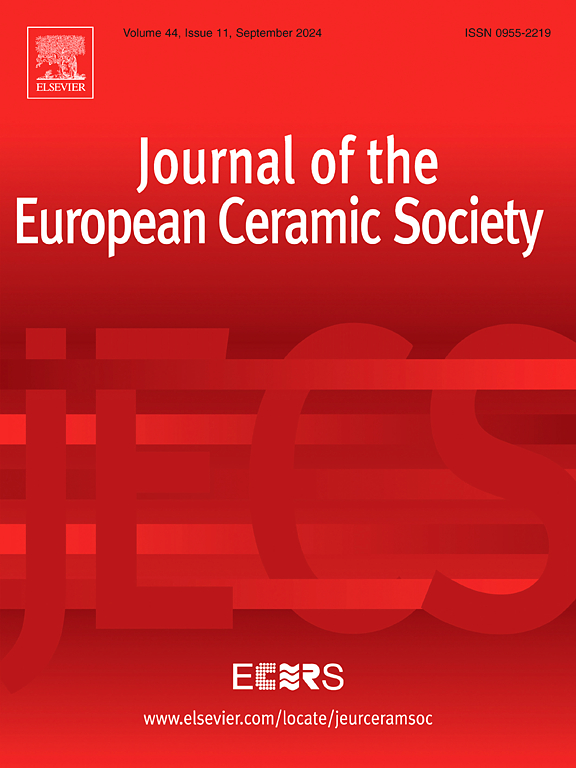Suppressing intrinsic self-compensating of BaSm2Ti4O12-δ ceramics for high-temperature thermistor application
IF 5.8
2区 材料科学
Q1 MATERIALS SCIENCE, CERAMICS
Journal of The European Ceramic Society
Pub Date : 2025-04-21
DOI:10.1016/j.jeurceramsoc.2025.117475
引用次数: 0
Abstract
BaSm2Ti4O12 (BSTO) material is promising for high-temperature thermistor applications owing to its excellent thermal stability and sensitivity coefficients. However, above 973 K, the increase in oxygen vacancies triggers the self-compensating effect of BSTO, leading to a de-localization of the localized states in the forbidden band and electrical properties deviating from the Arrhenius equation. Herein, we propose a Passive Variable-Range Hopping (PVRH) conduction mechanism to explain the nonlinear nature. Meanwhile, we suppress oxygen vacancy formation using Tb3.5 + doping and enhance structural stability through high-temperature aging, ensuring the electrical properties of BSTO materials follow the Arrhenius equation. In particular, the electrical properties of the BaTb0.2Sm1.8Ti4O12-δ sample demonstrate an excellent linear correlation with the Arrhenius equation, achieving a Pearson coefficient of 99.992 % across 723–1273 K. and maintaining a sensitivity coefficient as high as −1.28 % at 1273 K. This study provides valuable theoretical support for the development of high-temperature thermistors with high-precision.
抑制高温热敏电阻用BaSm2Ti4O12-δ陶瓷的本征自补偿
由于其优异的热稳定性和灵敏度系数,BaSm2Ti4O12 (BSTO)材料在高温热敏电阻中应用前景广阔。然而,在973 K以上,氧空位的增加触发BSTO的自补偿效应,导致禁带局域态的去局域化,电学性质偏离Arrhenius方程。在此,我们提出一种无源变程跳频(PVRH)传导机制来解释非线性特性。同时,我们通过Tb3.5 +掺杂抑制氧空位的形成,通过高温老化增强结构稳定性,确保BSTO材料的电学性能符合Arrhenius方程。特别是,BaTb0.2Sm1.8Ti4O12-δ样品的电学性能与Arrhenius方程表现出良好的线性相关性,在723-1273 K上的Pearson系数为99.992 %。在1273 K下保持灵敏度系数高达- 1.28 %。该研究为研制高精度高温热敏电阻提供了有价值的理论支持。
本文章由计算机程序翻译,如有差异,请以英文原文为准。
求助全文
约1分钟内获得全文
求助全文
来源期刊

Journal of The European Ceramic Society
工程技术-材料科学:硅酸盐
CiteScore
10.70
自引率
12.30%
发文量
863
审稿时长
35 days
期刊介绍:
The Journal of the European Ceramic Society publishes the results of original research and reviews relating to ceramic materials. Papers of either an experimental or theoretical character will be welcomed on a fully international basis. The emphasis is on novel generic science concerning the relationships between processing, microstructure and properties of polycrystalline ceramics consolidated at high temperature. Papers may relate to any of the conventional categories of ceramic: structural, functional, traditional or composite. The central objective is to sustain a high standard of research quality by means of appropriate reviewing procedures.
 求助内容:
求助内容: 应助结果提醒方式:
应助结果提醒方式:


